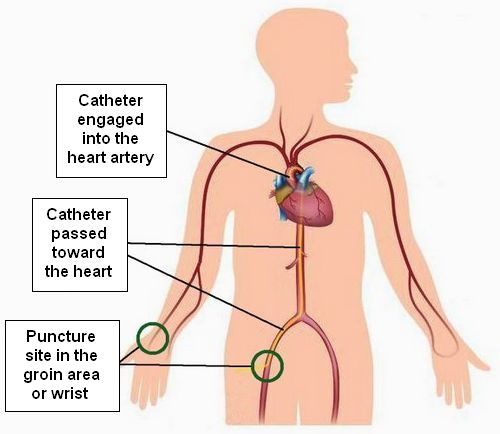What you need to know about a Coronary Angiogram
Contents
A coronary angiogram is a procedure that uses X-ray imaging to find out if your coronary arteries are narrowed or blocked, where and by how much. It is a part of a general group of procedures called cardiac (heart) catheterizations, which can diagnose and treat blood vessel and heart conditions. A coronary angiogram is the most common type of cardiac catheterization procedure.
A coronary angiogram can be used to diagnose conditions of the heart, plan future treatments, and complete certain procedures. Your doctor may recommend the procedure if you have:
-
Pain in your chest, neck, arm, or jaw that cannot be explained by other tests
-
Symptoms of coronary artery disease, such as angina (chest pain)
-
New or increasing chest pain
-
A congenital heart disease (a heart defect you were born with)
-
A chest injury or blood vessel problems
-
A heart valve problem.
In some cases, your doctor may also suggest this procedure if they found something abnormal in a noninvasive heart stress test. The procedure can also be performed after a heart attack or to plan surgical procedures, such as coronary angioplasty and where blocked or narrowed blood vessels are widened.

What does the Procedure Involve?
During a coronary angiogram, you will lie on your back on an X-ray table. Safety straps may be fastened across your chest and legs because the table may be tilted throughout the procedure.
To start the procedure, your doctor may shave a small amount of hair from your arm or groin where a catheter (a long, thin, flexible tube) will be inserted. The area is then washed and disinfected. You will be given a local anesthetic to numb the affected area and sedative to make you relax, but you will stay awake.
Your doctor will create an incision on your groin or arm, then insert a short plastic tube (sheath) into an artery. When the sheath is inserted into your artery, you may feel a dull pressure. It will hurt no more than a blood test. Then, the catheter is inserted through the sheath into your blood vessel and guided carefully up to your heart or coronary arteries. Inserting and guiding the catheter does not usually cause any pain and it is unlikely that you will feel it moving through your body. Therefore, always tell your health care team if you experience any discomfort.
A special type of dye (contrast material) will be injected through the catheter. You may experience a brief sensation of warmth of flushing when this happens. The dye can be seen easily on X-ray images. Your doctor can observe the dye’s flow as it moves through your blood vessel and identifies any constricted areas or blockages.
In some cases, your doctor may perform a stent insertion or a balloon angioplasty during a coronary angiogram.
When the procedure is completed, your doctor will remove the catheter and close the incision.
How Long Should I Stay at my Destination?
You may be able to leave the hospital on the same day, or you may need to stay overnight. Since you will need to see your doctor in a week after the test, it is advisable that you stay in the area for at least 7 to 8 days.
What’s the Recovery Time?
Most people are able to get back to work (office work) within 1-2 days. However, you may feel a little bit tired and the wound site is likely to remain tender for around seven days. It is advisable that you avoid any strenuous activities, such as heavy lifting and vigorous exercise, for at least a week.
What About Aftercare?
Your doctor will give you detailed aftercare instructions. It is important that you follow everything to avoid any complications. You generally should:
-
Drink plenty of water to flush the dye from your body.
-
Do not smoke or drink alcohol during your recovery period.
-
Rest and relax. These can help make your recovery time quicker.
-
Remove the bandage after 24 hours. You can apply a fresh bandage for another 12 hours if there is minor oozing.
-
You may shower, but do not take a bath, swim, or use a hot tub for at least three days.
What’s the Success Rate?
A coronary angiogram is a safe and practical procedure. According to a study, the procedure has a success rate of around 97.6%.
As with all procedures, there are some risks you need to be aware of. These include allergy to the contrast dye, bleeding, and damage to the artery, heart attack, kidney damage, and stroke. However, the chance of any of these risks happening is low.
Are there Alternatives to a Coronary Angiogram?
The alternative to coronary angiogram is coronary computed tomography angiography (CCTA). Unlike traditional coronary angiogram, this procedure is not invasive. During this procedure, iodine-containing contrast material is injected and CT scan is used to examine your arteries.
For an in-depth analysis of a Coronary Angiogram Procedure, watch this short video.
To check prices or to book a Coronary Angiogram Procedure, in Thailand or anywhere else in the world, head on over to MyMediTravel now!

